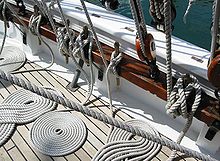Occupy

In shipping, mooring means the mooring of ropes on suitable devices, for example on a cleat , a bollard , a clamp or a mooring ring , or in traditional sailing ships on a mooring nail .
Occupy on the cleat
To lay on the cleat or to lay on a cleat , the line is first guided around the cleat on the side opposite to the pulling direction, that is to say on the side of the cleat further away from the object to be fastened . Then the line is crossed around the cleat two to four times. Finally there is a head blow . The securing head blow is correct when his ropes cross over the cleat.
If the cleat is attached vertically, for example on the mast , the head blow must be made on the upper mandrel of the cleat. If it were done at the bottom, it would loosen itself by gravity.
Occupy on the bollard
Mooring lines are attached to the bollard with a spliced eye . The eye is put over the bollard and the loose end of the line is attached to the ship (e.g. on a cleat ). If there is no eye line, the eye is tied with a bowline . Or the line is with a thrown clove hitch busy or wrapped twice around the bollard and two half hitches secured.
If several ships use a bollard, an incoming ship would prevent those already lying from loosening the lines. To prevent this, when mooring with an eye line, the new mooring line is inserted from below through the eye of the existing mooring line and then thrown over the bollard. This ensures that each of the ships can unload independently of the others.
In large ports, ship fasteners are busy fixing the mooring cables of mooring ships to the bollards.
Occupied by clamping device
Various clamping devices have been designed for covering, the best known are the curry clamp and the rope or trap stopper .





